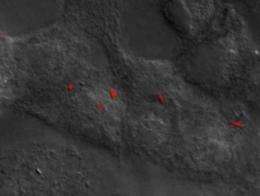Humanized mice may provide clues to better prevent and treat typhoid fever

Better treatments and prevention for typhoid fever may emerge from a laboratory model that has just been developed for the disease. The model is based on transplanting human immune stem cells from umbilical cord blood into mice that are susceptible to infections.
The transplanted cells live alongside the mouse's own immune system. Although mice are normally resistant to the dangerous strain of Salmonella that causes typhoid fever, the bacteria are able to reproduce in the mice that have received transplanted human cells.
Because typhoid fever affects only humans, progress in creating more effective vaccines and medications has been limited, notes Dr. Ferric C. Fang, professor of laboratory medicine and microbiology at the University of Washington (UW) in Seattle and the senior scientist on the project. The new model enables scientists to study innovative approaches against the disease in a living system, before testing them on people.
The "humanized" mouse model for studying Salmonella typhi infections was reported recently in the Proceedings of the National Academy of Sciences. The lead author of the paper is Stephen J. Libby, research associate professor of laboratory medicine.
The World Health Organization estimates that more than 16,000,000 new cases of typhoid fever occur annually. More than 600,000 people die each year from the disease, which is transmitted through contaminated food or water. Making the situation worse, multi-drug resistant strains have emerged. Researchers are looking for new drugs to replace those that are no longer effective.
The current typhoid fever vaccines have protection rates ranging from 60 to 80 percent. The protection conferred by the present inoculation is short-lived, and doesn't have a booster effect, the researchers explained. The oral vaccine spoils easily if storage conditions aren't optimal - as is the case in many tropical countries where typhoid fever is common. It also requires multiple doses. Studies in travelers suggest that many fail to take the vaccine properly.
Most of what scientists know about how Salmonella causes disease comes from studying a strain called Salmonella typhimurium, which can infect both mice and humans.
However, Fang noted that Salmonella infections in mice have not been found to correlate well with human typhoid infections.
"The mouse Salmonella infection differs from human typhoid in a number of important respects," he said. Immunity to one strain is fundamentally distinct from immunity to the other. This complicates attempts to construct vaccines based on observations of mice infected with Salmonella typhimurium."
Fang added that Salmonella typhi, the cause of human typhoid fever, is highly adapted to people. It has evolved many ways to evade infection-fighting defenses inside humans. It can also enter and destroy disease-fighting cells. The bacteria induce inflammation where it is in their own self-interest, and suppress it when and where it might be a disadvantage, such as in the intestine. Salmonella has changed over time by acquiring new DNA, such as plasmids and bacteriophages, from other organisms. This borrowed DNA makes it more virulent to humans and other animal hosts.
The host-pathogen interactions in mouse typhoid and human typhoid fever are drastically removed from each other, Fang said.
The researchers demonstrated that human blood-forming cells engrafted into immune-deficient mice allowed the mice to be infected with the organism that causes human typhoid fever, and that the typhoid bacteria appeared to reproduce inside the human cells. The researchers were also able to use this model to look for genetic factors that the typhoid bacteria need to cause severe illness.
Based on their studies, the researchers believe that the new lab mouse model can provide an unprecedented opportunity to gain insights into how the human typhoid fever bacterium, Salmonella typhi, causes serious disease and to devise better strategies for the prevention of typhoid fever. Their research also demonstrates how mice engrafted with human stem cells can allow scientists to better understand human infections.














